Abstract
The concept of lubrication by a tribochemically generated oxide layer on the surface of silicon nitride is further investigated. Previous work has shown that low friction coefficients (μ≈0.1) are obtained in a range of sliding velocities and loads when otherwise unlubricated silicon nitride slides in humid air at temperatures between 150 and 650ºC. In order to verify the hypothesis that this behavior results from a competition between the growth of an oxide layer (with growth kinetics accelerated by friction) and its removal by wear, we have performed model experiments at room temperature, wherethe oxide layer is grown statically (i.e. without friction) and the friction coefficient and its evolution in time are subsequently measured. In order to avoid high friction by plowing, ultraflat surfaces were first prepared by sliding in water. The experiments showed that the oxide layer growing in humid air on silicon nitride produces a friction coefficient as low as μ≈0.05 that survives about 30 Newton meter of sliding, which corresponds to several hundred passes of the counterface. When sliding in water, the surface acquires a high friction coefficient (μ≈0.7) very rapidly. The difference in the lubricating properties of tribochemical surface layers on aluminum oxide and silicon nitride can be understood on the basis of the differing surface chemistries of these materials. We offer a tentative lubrication mechanism based on low adhesion between the oxide surface and the silicon nitride counterface and the structure of oxides grown inhumid ambients.
Similar content being viewed by others
References
E.E. Klaus and C.W. Lai, in “Solid and Liquid Lubricants for extreme environments” ASLE Spec. Publ.15 75 (1982)
H. Tomizawa and T.E. Fischer, ASLE Trans. 29 481 (1986)
T.E. Fischer and H. Tomizawa, Wear 105 29 (1985)
T.E. Fischer, Ann. Rev. Mater. Sci. 18 303 (1988)
K. Komvopoulos, N. Saka and N. P. Suh, J. Tribology (ASME Trans.) 107 452 (1985) and ibid. 108 301 (1986)
H. Tomizawa and T.E. Fischer, ASLE Trans. 30 41 (1987)
T. Sugita, K. Ueda and Y. Kanemura, Wear 97 1 (1984)
F.P. Fehlner, “Low-Temperature Oxidation, The Role of Vitreous Oxides” John Wiley and Sons, New York, (1986), p.180
S. Jahanmir and T.E. Fischer, Tribology Trans. 31 32 (1988)
R. Gates, S.M. Hsu and E.E. Klaus, STLE Trans. in press (preprint STLE 88-TC-5A-4)
K. Wefers and G.. Bell, “Oxides and Hydroxides of Aluminum” Technical Paper No. 19, Alcoa Research Laboratories, (1972)
R.K. Iler, “The Chemistry of Silica”, John Wiley and Sons, New York (1979), p. 622
H.M. Dalai, Y.P. Chiu and E. Rabinowicz, ASLE Trans. 18 211 (1975)
Author information
Authors and Affiliations
Rights and permissions
About this article
Cite this article
Fischer, T.E., Liang, H. & Mullins, W.M. Tribochemical Lubricious Oxides on Silicon Nitride. MRS Online Proceedings Library 140, 339–344 (1988). https://doi.org/10.1557/PROC-140-339
Published:
Issue Date:
DOI: https://doi.org/10.1557/PROC-140-339




